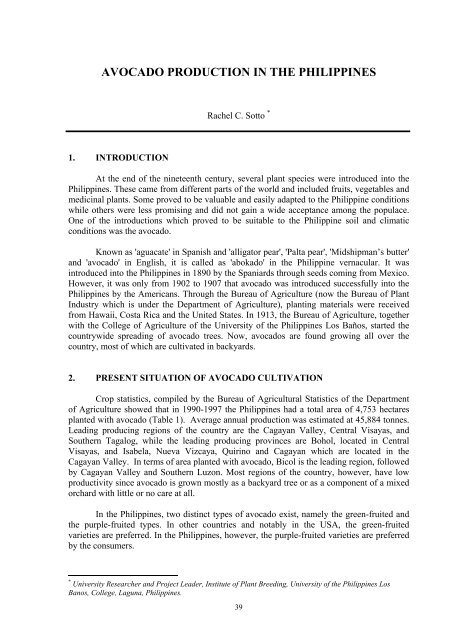Avocado Production in Asia and the Pacific - United Nations in ...
Avocado Production in Asia and the Pacific - United Nations in ...
Avocado Production in Asia and the Pacific - United Nations in ...
You also want an ePaper? Increase the reach of your titles
YUMPU automatically turns print PDFs into web optimized ePapers that Google loves.
AVOCADO PRODUCTION IN THE PHILIPPINES<br />
Rachel C. Sotto *<br />
1. INTRODUCTION<br />
At <strong>the</strong> end of <strong>the</strong> n<strong>in</strong>eteenth century, several plant species were <strong>in</strong>troduced <strong>in</strong>to <strong>the</strong><br />
Philipp<strong>in</strong>es. These came from different parts of <strong>the</strong> world <strong>and</strong> <strong>in</strong>cluded fruits, vegetables <strong>and</strong><br />
medic<strong>in</strong>al plants. Some proved to be valuable <strong>and</strong> easily adapted to <strong>the</strong> Philipp<strong>in</strong>e conditions<br />
while o<strong>the</strong>rs were less promis<strong>in</strong>g <strong>and</strong> did not ga<strong>in</strong> a wide acceptance among <strong>the</strong> populace.<br />
One of <strong>the</strong> <strong>in</strong>troductions which proved to be suitable to <strong>the</strong> Philipp<strong>in</strong>e soil <strong>and</strong> climatic<br />
conditions was <strong>the</strong> avocado.<br />
Known as 'aguacate' <strong>in</strong> Spanish <strong>and</strong> 'alligator pear', 'Palta pear', 'Midshipman’s butter'<br />
<strong>and</strong> 'avocado' <strong>in</strong> English, it is called as 'abokado' <strong>in</strong> <strong>the</strong> Philipp<strong>in</strong>e vernacular. It was<br />
<strong>in</strong>troduced <strong>in</strong>to <strong>the</strong> Philipp<strong>in</strong>es <strong>in</strong> 1890 by <strong>the</strong> Spaniards through seeds com<strong>in</strong>g from Mexico.<br />
However, it was only from 1902 to 1907 that avocado was <strong>in</strong>troduced successfully <strong>in</strong>to <strong>the</strong><br />
Philipp<strong>in</strong>es by <strong>the</strong> Americans. Through <strong>the</strong> Bureau of Agriculture (now <strong>the</strong> Bureau of Plant<br />
Industry which is under <strong>the</strong> Department of Agriculture), plant<strong>in</strong>g materials were received<br />
from Hawaii, Costa Rica <strong>and</strong> <strong>the</strong> <strong>United</strong> States. In 1913, <strong>the</strong> Bureau of Agriculture, toge<strong>the</strong>r<br />
with <strong>the</strong> College of Agriculture of <strong>the</strong> University of <strong>the</strong> Philipp<strong>in</strong>es Los Baños, started <strong>the</strong><br />
countrywide spread<strong>in</strong>g of avocado trees. Now, avocados are found grow<strong>in</strong>g all over <strong>the</strong><br />
country, most of which are cultivated <strong>in</strong> backyards.<br />
2. PRESENT SITUATION OF AVOCADO CULTIVATION<br />
Crop statistics, compiled by <strong>the</strong> Bureau of Agricultural Statistics of <strong>the</strong> Department<br />
of Agriculture showed that <strong>in</strong> 1990-1997 <strong>the</strong> Philipp<strong>in</strong>es had a total area of 4,753 hectares<br />
planted with avocado (Table 1). Average annual production was estimated at 45,884 tonnes.<br />
Lead<strong>in</strong>g produc<strong>in</strong>g regions of <strong>the</strong> country are <strong>the</strong> Cagayan Valley, Central Visayas, <strong>and</strong><br />
Sou<strong>the</strong>rn Tagalog, while <strong>the</strong> lead<strong>in</strong>g produc<strong>in</strong>g prov<strong>in</strong>ces are Bohol, located <strong>in</strong> Central<br />
Visayas, <strong>and</strong> Isabela, Nueva Vizcaya, Quir<strong>in</strong>o <strong>and</strong> Cagayan which are located <strong>in</strong> <strong>the</strong><br />
Cagayan Valley. In terms of area planted with avocado, Bicol is <strong>the</strong> lead<strong>in</strong>g region, followed<br />
by Cagayan Valley <strong>and</strong> Sou<strong>the</strong>rn Luzon. Most regions of <strong>the</strong> country, however, have low<br />
productivity s<strong>in</strong>ce avocado is grown mostly as a backyard tree or as a component of a mixed<br />
orchard with little or no care at all.<br />
In <strong>the</strong> Philipp<strong>in</strong>es, two dist<strong>in</strong>ct types of avocado exist, namely <strong>the</strong> green-fruited <strong>and</strong><br />
<strong>the</strong> purple-fruited types. In o<strong>the</strong>r countries <strong>and</strong> notably <strong>in</strong> <strong>the</strong> USA, <strong>the</strong> green-fruited<br />
varieties are preferred. In <strong>the</strong> Philipp<strong>in</strong>es, however, <strong>the</strong> purple-fruited varieties are preferred<br />
by <strong>the</strong> consumers.<br />
* University Researcher <strong>and</strong> Project Leader, Institute of Plant Breed<strong>in</strong>g, University of <strong>the</strong> Philipp<strong>in</strong>es Los<br />
Banos, College, Laguna, Philipp<strong>in</strong>es.<br />
39
















